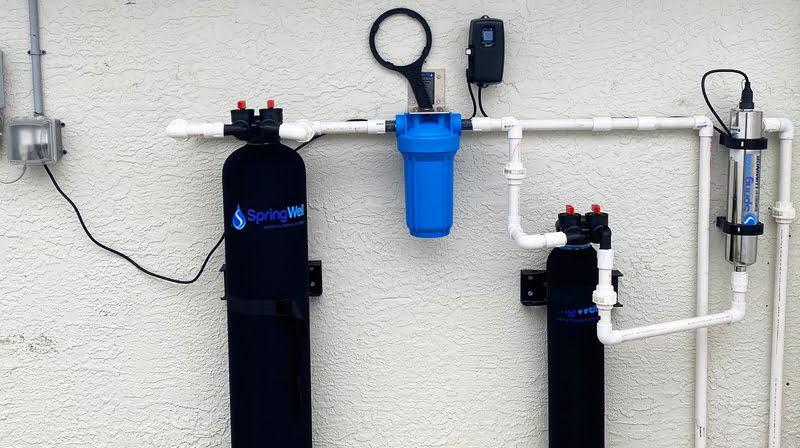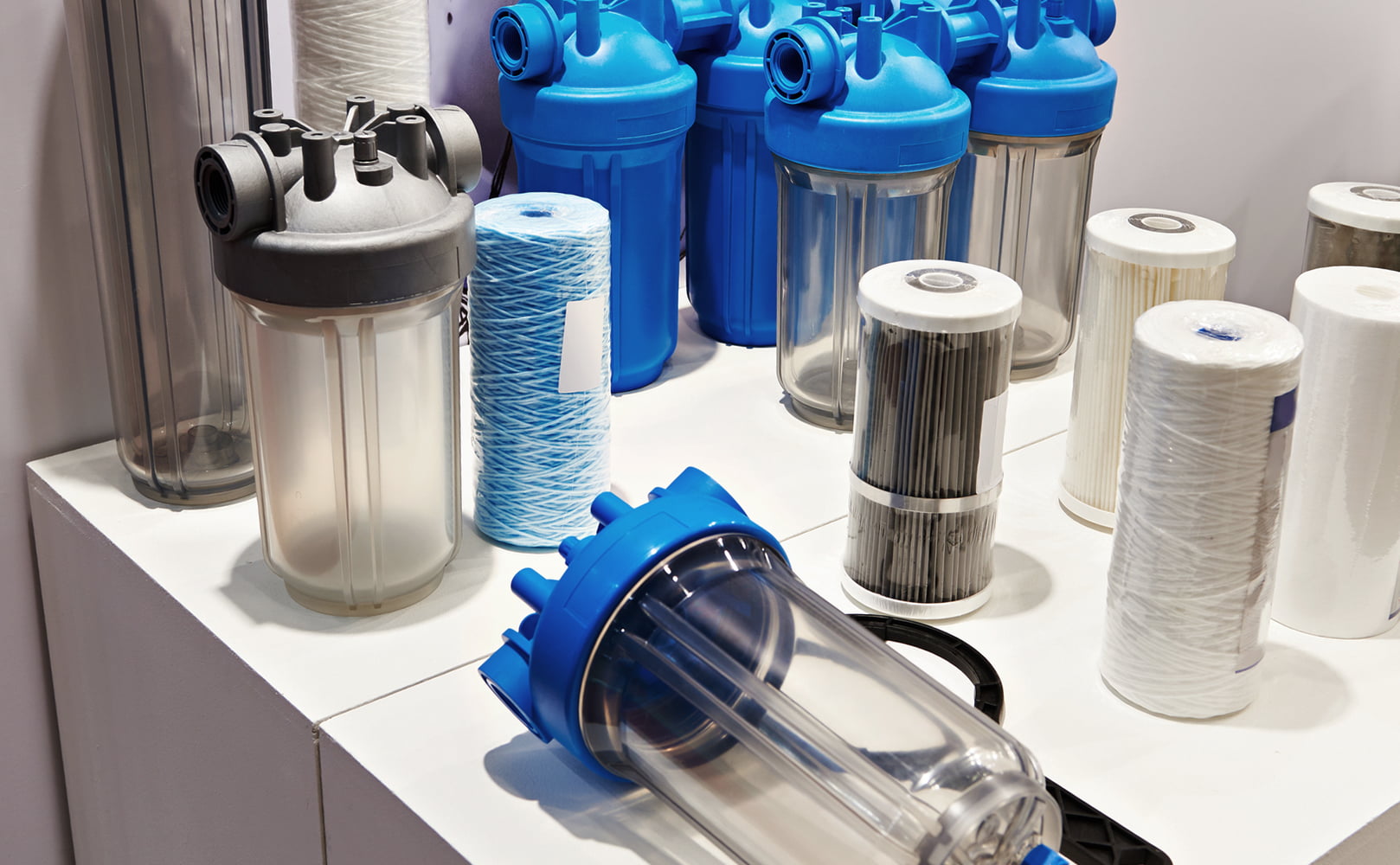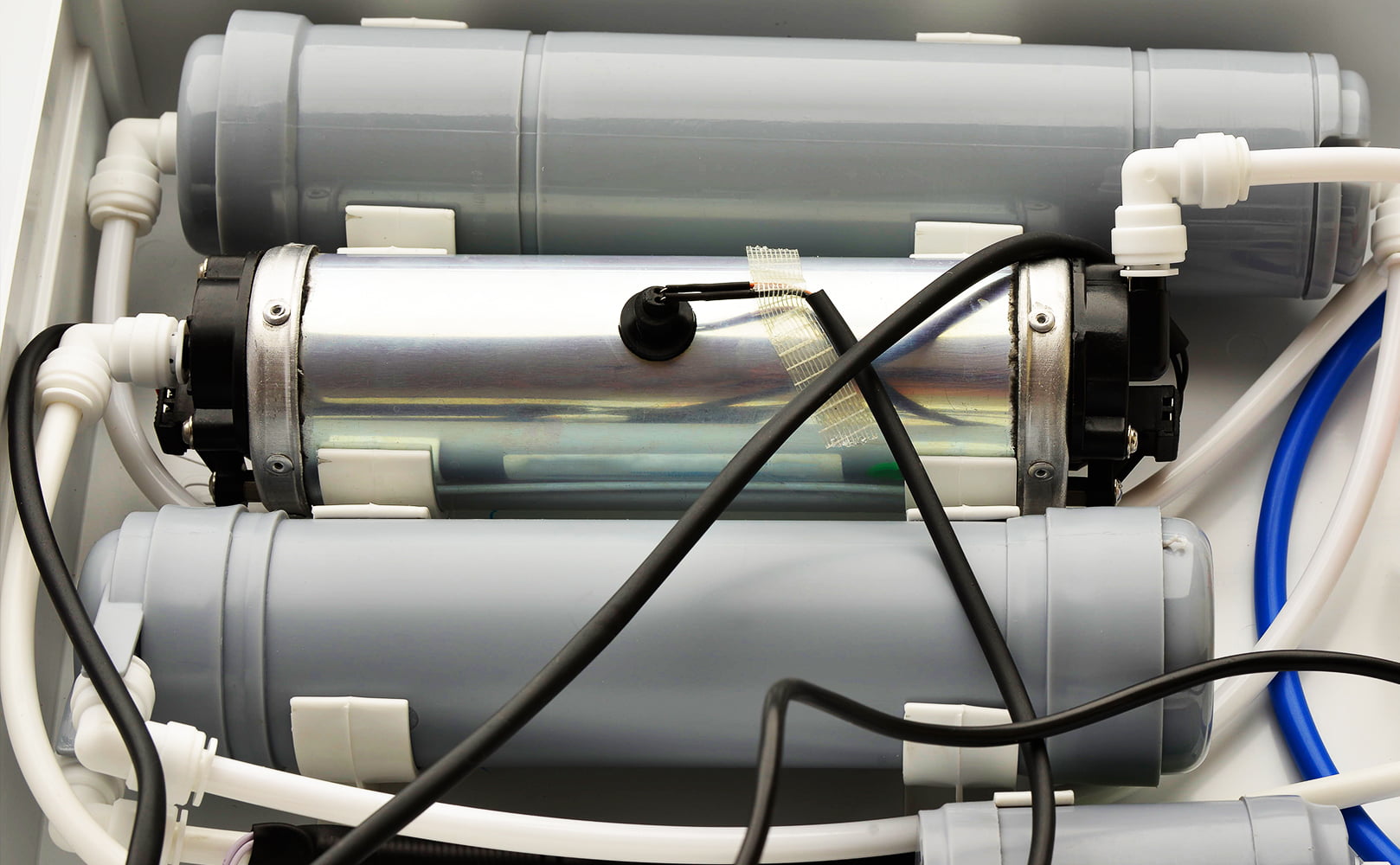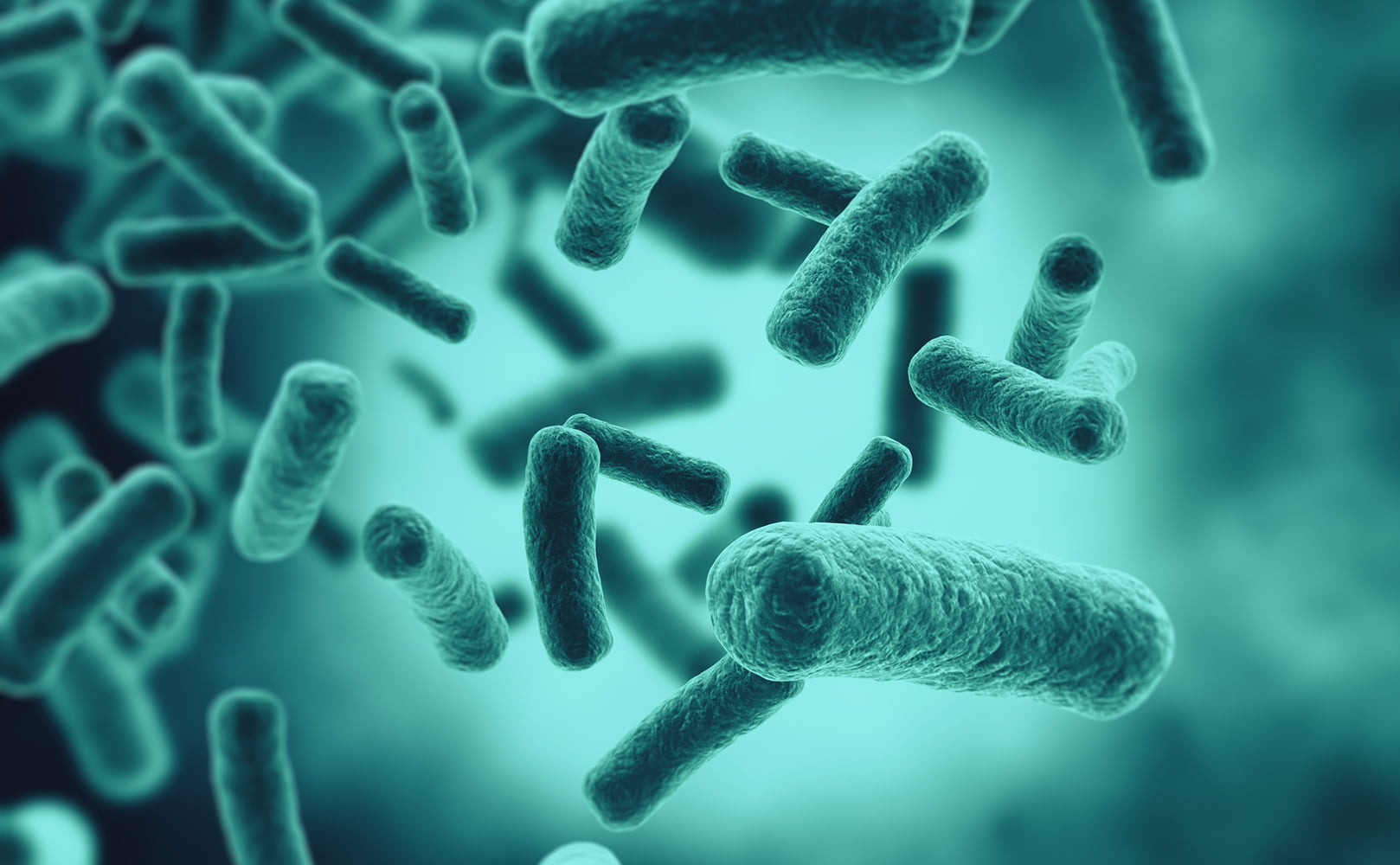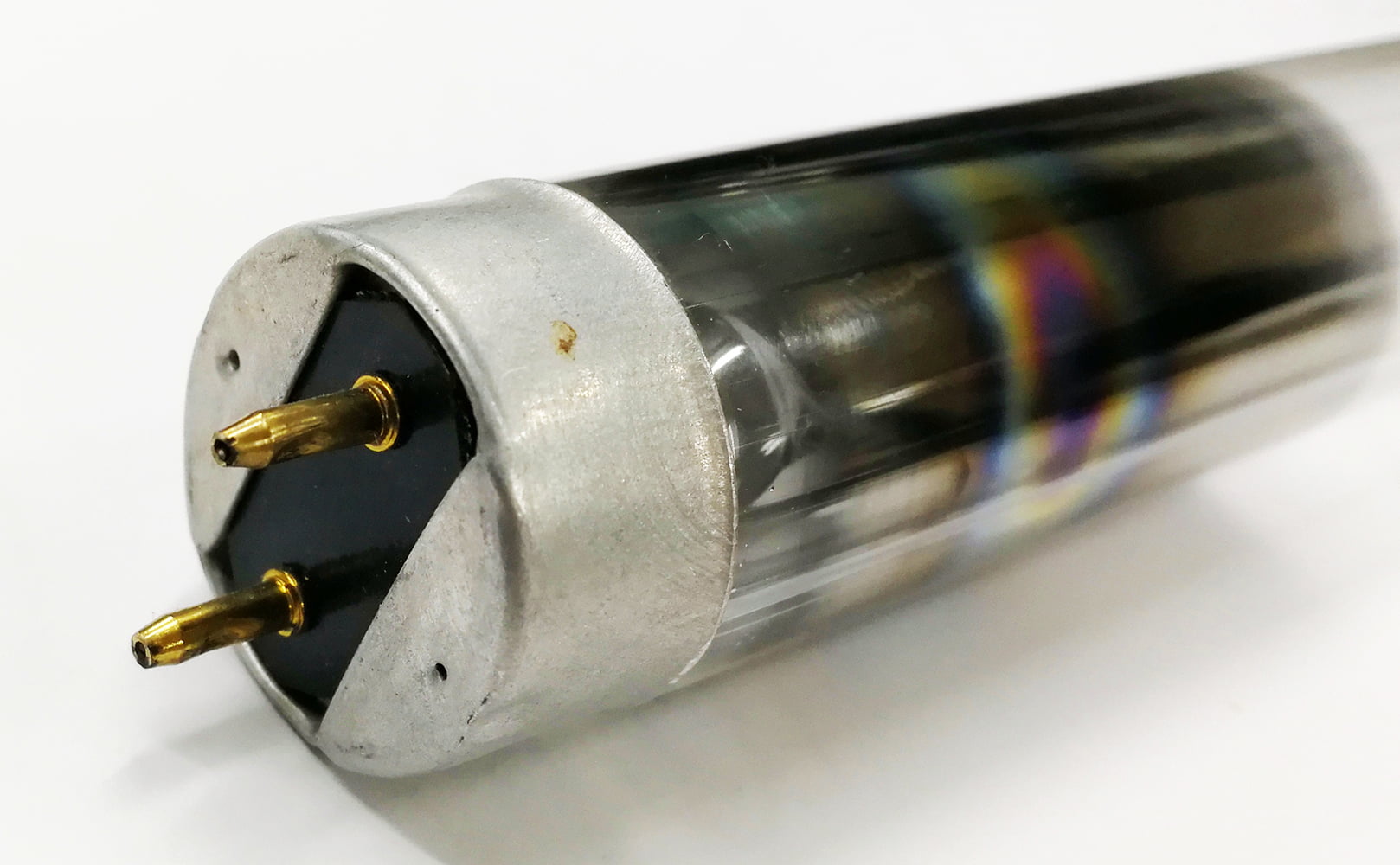7 Best UV Water Purifiers (*Update 2024)
Written by: Gene Fitzgerald // Last Updated: Jan 31, 2024
This page may contain affiliate links. If you buy a product or service through such a link we earn a commission at no extra cost to you. Learn more.
Top Pick: What’s the Best UV Water Purifier?
The best UV water purifier in 2024 is the SpringWell SPRW-UVC5-15m, because it is easy to install, it provides a high-enough UV dose of 30 mJ/cm² killing 99.9% of waterborne pathogens, it works for small to large homes, maintenance is affordable, and you get a 6-month money-back guarantee and a long warranty.
Looking for the ultimate UV water purifier? Look no further! With the market for UV water filters being vast, we understand the challenge of finding the perfect system for your needs. That’s why we’ve created this buying guide. Our team has evaluated over 17 different systems to bring you the top options available. Get ready to discover your ideal UV water purifier and enjoy pure, safe water with confidence.
No Time to Read? Check Our List of the Best UV Water Filters!
| UV Purifiers | Details | |
|---|---|---|
 Best for Whole House: SpringWell SPRW-UVC5-15m |
Overall Rating: 5.0/5.0
Get 5% Off! Use Code: |
Price: $$$ Type: Whole House Flow Rate: 15 gpm (Up to 5 Baths) Wattage: 50 Warranty: 1-10 Years Read Review: Click |
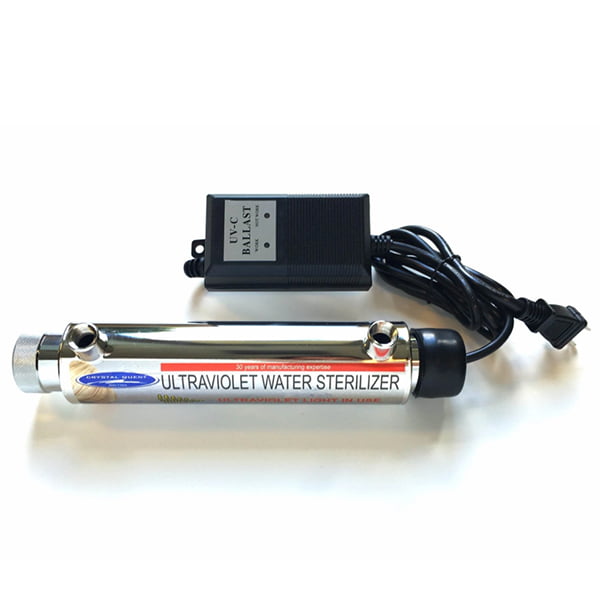 Best Point-of-Use: Crystal Quest CQE-UV-00101 |
Overall Rating: 5.0/5.0
Get 5% Off! Use Code: |
Price: $ Type: Single Outlet Flow Rate: 1.0 gpm Wattage: 11 Warranty: 1 Year Read Review: Click |
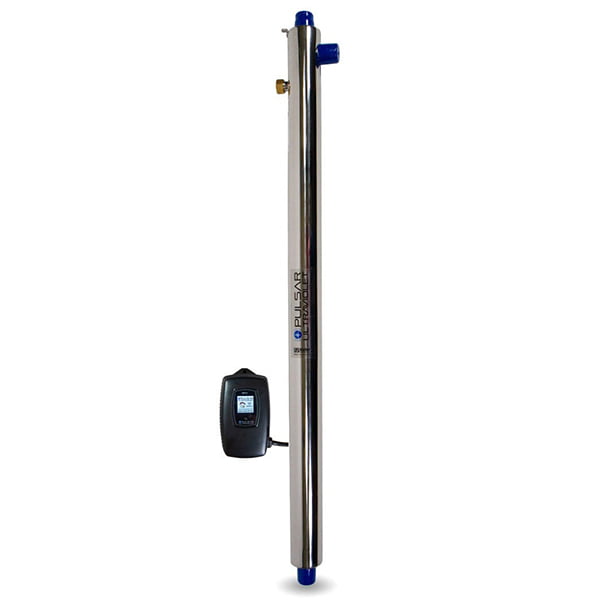 Best for Very Large Homes: USWS Pulsar UV Disinfection System |
Overall Rating: 4.5/5.0
Get 5% Off! Use Code: |
Price: $$$ Type: Whole House Flow Rate: 10-20 gpm (1-7+ Baths) Wattage: 49 Warranty: 3 Years, Lifetime Read Review: Click |
UV Water Purifier Reviews
Our Top Picks
- SpringWell SPRW-UVC5-15 – Best Whole House
- Pelican Standard – Runner-Up for Whole House
- Crystal Quest CQE-UV-00101 – Best Point of Use
- Acuva ArrowMAX 2.0 – Runner-Up for Point of Use
- USWS Pulsar – Highest Flow Rate
- Viqua VH410
- HQUA-OWS-12 – Best Budget Pick
1. Best for Whole House: SpringWell SPRW-UVC5-15 UV Water Purification System
In our opinion, the best UV water purifier in 2024 is the SpringWell SPRW-UVC5-15.
That’s because the whole house system provides strong UV water purification killing 99.9% of waterborne and potentially harmful pathogens including bacteria, viruses, and cysts. Thus you can enjoy safe water in your entire home.
Also, the SPRW-UVC5-15 is easy to install and operate, and features a controller monitoring system performance and remaining life of the UV lamp. And there is more!
Please note: We recommend using SpringWell’s PF-10 or PF-20 sediment pre-filter in conjunction.
Gallery
Other Specs
- Model: SPRW-UVC5-15
- Last Price: $1,100.99
- Annual Maintenance Cost: ~$110
- UV Dose: 30 mJ/cm²
- WxHxD: 4″x20″x4″
- Water Temperature: 36-104 °F
- Water Pressure: 10-150 psi
- Fitting: 1″ MNPT
Key Features & Pros
- System kills close to 100 percent of bacteria like E. coli, viruses, cysts including giardia and cryptosporidium, algae, and fungi.
- 15 gallons per minute water flow rate is ideal even for large homes with up to 5 bathrooms.
- At 30 mJ/cm² (millijoules per square centimeter), the required UV dose to eradicate typical pathogens found in home drinking water supplies is almost doubled.
- Provides a comfortable safety margin.
- For example: For E. coli only 6 mJ/cm² is required to kill 99.99%.
- Components are NSF-certified for lead compliance, meaning they are lead-free.
- Easy to install.
- SpringWell’s UV system controller tells you the remaining UV lamp life + monitors unit’s performance. It also helps with troubleshooting displaying error messages and diagnostics.
- For ease of use!
- Comes in a splash-proof case.
- You can upgrade with optional UV sensor module in order to monitor UV intensity.
- You won’t need to replace the UV light bulb more than once year – convenient! Cost: ~$110 which is affordable.
- SpringWell customer service is rated A+.
- Free shipping, a 6-month risk-free satisfaction guarantee, and 1 to 10 years product warranty are added on top for complete peace of mind.
Cons
- If you don’t install a sediment water filter before the UV purifier, the product warranty will void.
- No deal breaker since using a 5-micron sediment pre-filter is recommended anyways.
- As with any other UV water filtration system, the SpringWell isn’t compatible with the following water conditions so that pre-treatment is required:
- Hardness ≥ 7 gpg
- Iron ≥ 0.3 ppm
- Manganese ≥ 0.05 ppm
- Turbidity ≥ 1 NTU
- Tannins ≥ 0.1 ppm
Our Rating
- Treatment Process: 5.0/5.0
- Lamp Life: 5.0/5.0
- Price: 4.0/5.0
- Maintenance Cost: 5.0/5.0
- Overall: 5.0/5.0
Best for
The SpringWell SPRW-UVC5-15 is best for people who want a whole house UV water purifier that’s easy to install and service, durable, highly effective, and backed by great customer service.
2. The Runner-Up: Pelican Standard UV Disinfection System
As an alternative to SpringWell, we recommend the Pelican Standard UV Disinfection System by Pentair.
Choose either the PUV-8-P or the PUV-16-P, depending on the size of your home, and enjoy UV disinfection inactivating 99.9% of viruses, bacteria, and other pathogens.
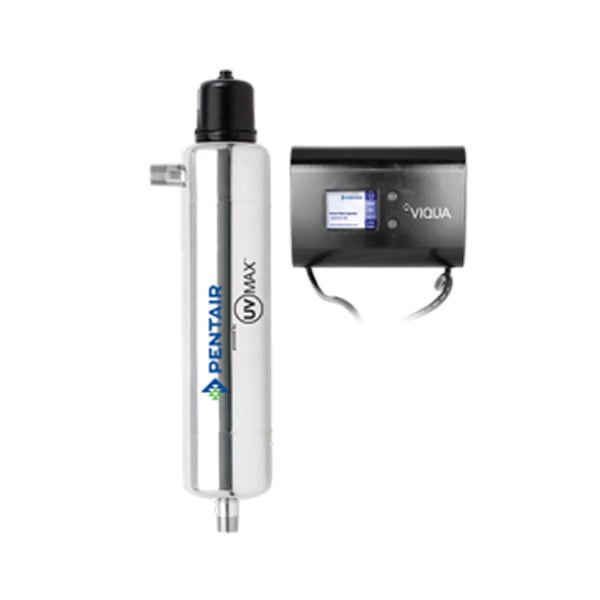
Pelican Standard UV Disinfection System |
|
| Price: | $$$ |
| UV Filter Type: | Whole House |
| Flow Rate: | 8.9-15.8 gpm (1-6 Baths) |
| Power: | 25-40 Watts |
| Warranty: | 1-10 Years |
|
Overall Rating: 4.5/5.0
|
|
Other Specs
- Model: PUV-8-P, PUV-16-P
- Annual Maintenance Cost: ~$150-175
- WxHxD: 10″x52-76″x10″
- Water Temperature: 32-104 °F
- Water Pressure: 4-125 psi
- Fitting: 3/4-1″ MNPT
- NSF Certification: Standard 55 (Class B)
- Other Certifications: CSA B483.1
Key Features & Pros
- Ideal for tap water and well water disinfection.
- UV light renders microorganisms unable to reproduce and infect.
- NSF/ANSI Standard 55 (Class B) certified to be 99.9% effective.
- Class B certification is for the reduction of non-disease causing bacteria in disinfected drinking water. Of course, the Pelican Standard UV Disinfection System also kills all the other microorganisms.
- Choose between two sizes:
- PUV-8-P provides 8.9 gallons per minute peak water flow for 1-3 bathrooms.
- PUV-16-P delivers up to 15.8 gallons per minute for up to 6 baths.
- Installation is about as demanding as installing most other whole house water treatment systems. Can be DIYed!
- LCD display shows lamp intensity status, remaining life, and other performance information for easy monitoring.
- Warning lights and sound alert about maintenance requirements – think UV lamp replacements.
- At 9,000 hours effective life, you need to change the UV lamp once a year which is child’s play. The lamp sleeve is recommended to be replaced every two years. Total cost: ~$150-175 which is acceptable.
- In order to prevent kids from accessing the electrical components, there is a safety cap.
- Pentair provides 10 years warranty on the UV chamber; 3 years on the electrical and other hardware; and 1 year on the UV lamp, quartz sleeve, and sensor.
Cons
- The following water conditions must be met: Hardness < 7 grains per gallon, iron < 0.3 ppm, manganese < 0.05 ppm, turbidity < 1 NTU, tannins < 0.1 ppm.
Our Rating
- Treatment Process: 4.5/5.0
- Lamp Life: 5.0/5.0
- Price: 4.0/5.0
- Maintenance Cost: 4.0/5.0
- Overall: 4.5/5.0
Best for
The Pelican is best for people who insist on NSF-certified disinfection of waterborne bacteria.
3. Best Point-of-Use System: Crystal Quest CQE-UV-00101 Ultraviolet Water Sterilizer System
In our opinion, the best UV water filter system for point-of-use applications is the Crystal Quest CQE-UV-00101.
It’s highly affordable and ideal for use in kitchens, offices, and RVs. Sounds promising? Then definitely check out the pros & cons of the Crystal Quest CQE-UV-00101 Ultraviolet Water Sterilizer System below!

Crystal Quest CQE-UV-00101 UV Filter |
|
| Price: | $ |
| UV Purifier Type: | Point of Use |
| Flow Rate: | 1 gpm |
| Power: | 11 Watts |
| Warranty: | 1 Year |
|
Overall Rating: 5.0/5.0
Get 5% Off! Use Code: |
|
Other Specs
- Model: CQE-UV-00101
- Last Price: $169.00
- Annual Maintenance Cost: $80
- UV Dose: 30 mJ/cm²
- WxHxD: 2.5″x11″x2.5″
- Water Pressure: Up to 85 psi
- Fitting: 1/4″ MNPT
Key Features & Pros
- 99.99% reduction of bacteria and virus and protozoa, according to Crystal Quest.
- Also great as an add-on to the company’s under sink water filtration systems.
- 1 gpm flow rate is much more than what the Acuva (next review) can provide. Fill a large cup or jug within seconds!
- We have a highly durable and long-lasting 304 stainless steel reactor chamber!
- An LED indicates when the system is running.
- Choose between 110v or 220v voltage.
- Installs easily also thanks to readable and detailed instruction manual.
- Requires no attention to operate.
- You get 9,000 hours (about 1 year) out of each ultraviolet light bulb. Cost per piece: $80 – fair!
- An audible sound will notify you about lamp failure.
Cons
- If a qualified and licensed plumber does not do the installation, the 1-year product warranty could void.
Our Rating
- Treatment Process: 5.0/5.0
- Lamp Life: 5.0/5.0
- Price: 5.0/5.0
- Maintenance Cost: 5.0/5.0
- Overall: 5.0/5.0
Best for
The Crystal Quest CQE-UV-00101 is best for people looking for a POU UV purifier that’s easy to install and maintain, durable, highly effective, and fast.
4. The Runner-Up for POU: Acuva ArrowMAX 2.0 UV-LED Water Purifier
In case you have a bigger budget, take a look at the Acuva ArrowMAX 2.0.
It not only eliminates up to 99.9999% of bacteria and viruses but also improves water taste & odor and removes harmful contaminants.

Acuva ArrowMAX 2.0 UV Purifier |
|
| Price: | $$ |
| UV Purifier Type: | Point of Use |
| Flow Rate: | 0.52 gpm |
| Power: | 9 Watts |
| Warranty: | 1 Year |
|
Overall Rating: 4.5/5.0
|
|
Other Specs
- Model: ArrowMAX 2.0
- Annual Maintenance Cost: $50
- UV Dose: 16 mJ/cm²
- WxHxD: 9.875″x1.875″x4.125″
- Water Temperature: 39-105 °F
- Water Pressure: 12-100 psi
- NSF Certification: Standard 55 (Class B), 372
- Other Certifications: CSA B483.1
Key Features & Pros
- First, the pre-filter removes 99% chlorine (NSF certified), lead, chromium 6, mercury, and nickel. It also reduces 95% fluoride, says Acuva. Other water contaminant levels like asbestos are lowered, too.
- Provides for much healthier drinking water with improved aesthetics.
- The pre-filter also traps sediments (turbidity) for a more effective UV treatment process.
- The ArrowMAX 2.0 itself uses LED UV lights to destroy as much as 99.9999% of viruses and bacteria making your water much safer for consumption.
- We have an NSF/ANSI standard 55 Class B certification for guaranteed performance.
- There is an optional brushed-nickel smart faucet. It glows blue to indicate that the unit is active and effectively working.
- This UV water purification system is easy to install.
- For self-cleaning, a “UV burst” ensures all water within the UV purifier is sanitized. In other words, the system is maintenance-free. Only the pre-filter requires changing after 4,000 gallons of UV filtered water or 12 months, whichever comes first.
- Expected life is 31,700 gallons of UV-disinfected water or 7+ years.
- 30-day return policy.
- 1 year warranty.
Cons
- Highest price tag in this category.
- Some people might find the 0.52 gpm flow rate rather low but it still fills a regular cup of water within 10 seconds.
Our Rating
- Treatment Process: 5.0/5.0
- Lamp Life: 5.0/5.0
- Price: 3.5/5.0
- Maintenance Cost: 5.0/5.0
- Overall: 4.5/5.0
Best for
The Acuva ArrowMAX 2.0 is best for people who want NSF-certified water disinfection combined with thorough water filtration at a single outlet.
5. Best for Very Large Homes: US Water Systems Pulsar Ultraviolet Disinfection System
With the USWS Pulsar Ultraviolet Disinfection System, UV rapidly destroys any living and potentially harmful microorganisms in your home’s water supply. The purification process targets bacteria, viruses, and protozoa using germicidal wavelengths.
What’s special about this UV water filter is that it’s built in Canada.

USWS Pulsar UV Filter |
|
| Price: | $$$ |
| UV System Type: | Whole House |
| Flow Rate: | 10-20 gpm (1-7+ Bathrooms) |
| Power: | 49 Watts |
| Warranty: | 3 Years, Lifetime |
|
Overall Rating: 4.5/5.0
Get 5% Off! Use Code: |
|
Other Specs
- Model: 405-PUV-200-BGF
- Last Price: $795.00-995.00
- Annual Maintenance Cost: ~$110
- UV Dose: 30 mJ/cm²
- WxHxD: 2.5-3.5″x35.2-40.0″x2.5-3.5″
- Water Temperature: 36-104 °F
- Water Pressure: Up to 150 psi
- Fitting: 3/4-1″ MNPT
Key Features & Pros
- 30 mJ/cm² provide for sufficient UV transmittance in the water rendering it free from all the bacteria, viruses, and cysts.
- You can choose from 3 system sizes depending on how much water you need:
- 10 gpm for 1-3 bathrooms.
- 15 gpm for 4-5 bathrooms.
- 20 gpm for 7+ baths.
- Optional 1-micron pleated polyester pre-filter traps sediments and other large particles.
- Using a pre-filter rules out shadowing where pathogens hide behind suspended solids avoiding UV exposure.
- Made in USA.
- UV chamber is made from durable stainless steel for prolonged life.
- Straightforward installation, maintenance, and service.
- The waterproof power supply displays remaining lamp life and features a visual and audible replacement reminder.
- 9,000 hours lamp life means you only have to replace once a year. Cost: ~$110.
- Can be changed without interrupting water flow.
- Warranty: Lifetime on chamber and 3 years on electronics.
Cons
- The sediment pre-filter limits output flow to 12 gpm.
- USWS does not offer a trial period on their products.
Our Rating
- Treatment Process: 4.5/5.0
- Lamp Life: 5.0/5.0
- Price: 4.0/5.0
- Maintenance Cost: 5.0/5.0
- Overall: 4.5/5.0
Best for
The USWS Pulsar is best for people living in a very large household.
6. Viqua VH410 Whole Home UV System
Our next UV water purifier review features the Viqua VH410.
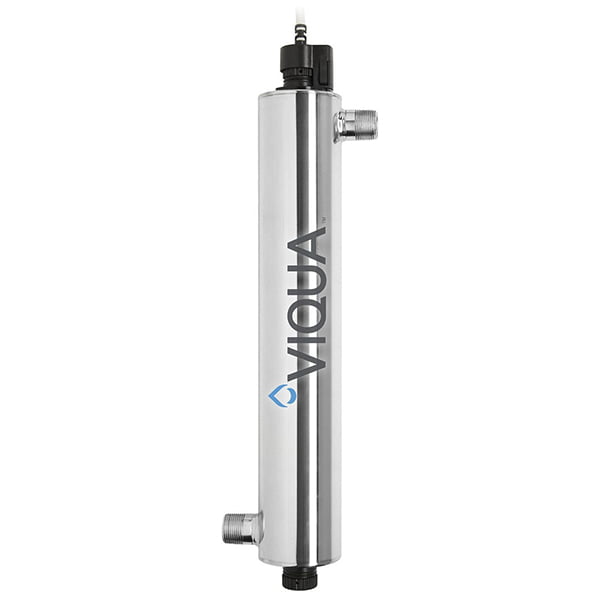
Viqua VH410 UV Purifier |
|
| Price: | $$ |
| UV Purification System Type: | Whole House |
| Flow Rate: | 18 gpm (Up to 6+ Bathrooms) |
| Power: | 60 Watts |
| Warranty: | 1-10 Years |
|
Overall Rating: 4.0/5.0
|
|
Other Specs
- Model: VH410
- Annual Maintenance Cost: ~$140
- UV Dose: 30 mJ/cm²
- WxHxD: 3.5″x23.5″x3.5″
- Water Temperature: 36-104 °F
- Water Pressure: 15-125 psi
- Fitting: 3/4-1″ MNPT
Key Features & Pros
- The Viqua VH410 disinfects water for the entire home. Thus you get water that is safe to use at every outlet.
- At a UV dose of 30 mJ/cm², flow rate is up to 18 gpm which is plenty of water even for large households.
- The chamber containing UV lamp and quartz sleeve is made from stainless steel for longevity.
- Safety cap + lamp plug prevent accidental access to the UV lamp.
- The controller unit reminds you when it’s time to replace the UV light bulb (after 9,000 hours). Cost per piece: ~$110.
- Controller also has visual power indicator and displays remaining lamp life.
- The seller QWT offers a 100% customer satisfaction guarantee covering the first 60 days after purchase. If you are unhappy with the product, you can return it for a full refund.
- Only when purchased from qualitywatertreatment.com.
- We have a 10-year limited warranty on the UV chamber and a 3-year warranty for electrical and hardware components. UV lamp, sleeve, and sensor are warranted for 1 year.
- All in all you are fully covered.
Cons
- We will update this section if anything comes up.
Our Rating
- Treatment Process: 4.0/5.0
- Lamp Life: 5.0/5.0
- Price: 4.0/5.0
- Maintenance Cost: 4.5/5.0
- Overall: 4.0/5.0
Best for
The Viqua VH410 is a POE system best for large homes.
7. Best Budget Option: HQUA-OWS-12 Ultraviolet Water Purifier
Last but not least, let’s look at a budget option: The HQUA-OWS-12 Ultraviolet Water Purifier.
What makes it stand out from the competition is the comparatively low price tag. However, the unit doesn’t come without drawbacks (more below).

HQUA-OWS-12 UV Purifier |
|
| Price: | $ |
| UV Purification System Type: | Whole House |
| Flow Rate: | 12 gpm (1-4 Baths) |
| Power: | 40 Watts |
| Warranty: | 1-10 Years |
|
Overall Rating: 3.5/5.0
|
|
Other Specs
- Model: HQUA-OWS-12
- Annual Maintenance Cost: ~$40
- UV Dose: 30 mJ/cm²
- WxHxD: 2.5″x37.5″x2.5″
- Fitting: 3/4″ MNPT
Key Features & Pros
- This cheap UV filter system comes with 1 extra UV tube.
- You get 12 gallons per minute out of this HQUA system at 30 mJ/cm² UV exposure.
- For homes with up to 3-4 bathrooms.
- The 304 food-grade stainless steel chamber seems durable.
- Chamber is warranted for 10 years, electronic ballast for 1 year.
Cons
- The biggest issue is leaking. Some people couldn’t fix their leaks no matter what they did and how often they tried.
- This is probably due to the design of the quartz glass and silicone washers.
- We also read about broken sleeves and ballasts.
- The process is simple but installation instructions could do with an improvement.
- The UV lamp might not make the full 365 days as claimed which adds extra cost.
Our Rating
- Treatment Process: 3.5/5.0
- Lamp Life: 5.0/5.0
- Price: 5.0/5.0
- Maintenance Cost: 5.0/5.0
- Overall: 3.5/5.0
Best for
The HQUA-OWS-12 UV water purifier is best for people on a smaller budget.
Comparison List
(Mobile Hint: Swipe to Scroll)
| UV Systems | Price | Type | GPM | Wattage | UV Dose | NSF | Annually | Warranty | Additional Info |
|---|---|---|---|---|---|---|---|---|---|
| SpringWell SPRW-UVC5-15 UV Water Purification System | $$$ | POE | 15 | 50 | 30 mJ/cm² | ~$110 | 1-10 Years | ||
| Pelican Ultra-Violet (UV) Disinfection System | $$$ | POE | 8.9-15.8 | 25-40 | Standard 55 (Class B) | ~$150-175 | 1-10 Years | ||
| Crystal Quest CQE-UV-00101 Ultraviolet Water Sterilizer System | $ | POU | 1 | 11 | 30 mJ/cm² | $80 | 1 Year | ||
| Acuva ArrowMAX 2.0 UV-LED Water Purifier | $$ | POU | 0.52 | 9 | 16 mJ/cm² | Standard 55 (Class B), 372 | $50 | 1 Year | |
| US Water Systems Pulsar Ultraviolet Disinfection System | $$$ | POE | 10-20 | 49 | 30 mJ/cm² | ~$110 | 3 Years to Life | ||
| Viqua VH410 Whole Home UV System | $$ | POE | 18 | 60 | 30 mJ/cm² | ~$140 | 1-10 Years | ||
| HQUA-OWS-12 Ultraviolet Water Purifier | $ | POE | 12 | 40 | 30 mJ/cm² | ~$40 | 1-10 Years |
Buying Guide: How to Choose the Ultraviolet Water Purification System That’s Best for You
The following are key features worth considering when shopping for a UV water purifier. They will help you choose the right on for your needs and budget.
Water Quality and Pre-Filtration (Sediments)
Using a UV filter, you need to make sure your water meets certain criteria in order for the disinfection process to be effective.
This is because bacteria and other waterborne organisms are so tiny that they can hide behind the particulates floating in dirty water. It’s an issue called “shadowing”.
In other words, shadowing is why we usually find pre-filtration in front of UV systems. The most basic pre-filtration would be a 5-micron sediment filter removing dirt, sand, rust, and more. However, a well water supply might require sediment filtration, iron removal, and water softening before a UV purifier can get to work.
Bottom line: Test your water quality and check if it meets the following conditions. If it doesn’t, you should get the necessary treatment in place:
- Hardness < 7 grains per gallon (gpg)
- Iron < 0.3 ppm
- Manganese < 0.05 ppm
- Turbidity < 1 NTU
- Tannins < 0.1 ppm
UV Dose
The UV dose or dosage is the amount of energy, measured in millijoules per square centimeter (mJ/cm²) or sometimes µwatt*sec/cm², delivered by an ultraviolet water filter. Higher dosage means more energy provided. At a certain level, the amount of energy is sufficient to inactivate exposed microorganisms by scrambling their DNA impeding reproduction.
What level of UV dose is ideal for water disinfection?
Generally speaking, there should be a lamp intensity of at least 16 mJ/cm². It’s the bare minimum threshold established by the U.S. Department of Health and Human Services in the 1960s, which kills the majority of harmful bacteria and cysts. Today, however, most manufacturers provide a higher intensity of 30 mJ/cm² or more. This provides for a safety margin in case UV transmittance isn’t ideal and it affects viruses, too.
For a more detailed answer, the required UV dose depends on the specific pathogen or pathogen group you are facing. For example, E. coli bacteria require a UV dose of 6 to 7 mJ/cm². At this dose, 99.99% (log 4) E. coli cells will be destroyed.
Here is an overview of water pathogens and their required UV dose for log 4 (99.99%) inactivation:
| Pathogen | UV Dosage (mJ/cm²) |
|---|---|
| Escherichia coli | 6 to 7 |
| Cryptosporidium parvum oocysts | <10 |
| Giardia lamblia cysts | <10 |
| Vibrio cholerae | 2.9 |
| Salmonella typhi | 8.2 |
| Shigella sonnei | 8.2 |
| Hepatitis A virus | 30 |
| Poliovirus Type 1 | 30 |
| Rotavirus SA11 | 36 |
Additional Water Treatment
You need to remember that UV water purification only inactivates pathogenic contaminants.
It neither alters your water’s chemistry, nor does it improve water aesthetics.
So if, for instance, you are dealing with excessive chlorine levels, you would need additional water treatment equipment; in this case an activated carbon filter.
Flow Rate (Size)
The size of a UV system is directly proportional to the amount of water that can flow through it at any given time.
Basically, the water must be exposed to enough UV light to allow for proper treatment. And this is mainly a question of flow rate and lamp intensity. Or simply put, faster flow rates require a larger and more powerful UV lamp.
This flow rate must be matched to the size of your household – think number of bathrooms and family members.
- Around 10 gallons per minute water flow rate is enough to provide 1-3 bathrooms.
- About 15 gpm are required if you have 4 to 6 bathrooms.
- For 7 or more bathrooms up to 20 gpm are recommended.
Wattage
When you check the above reviews, UV light bulbs don’t require that much power. In terms of wattage, they can be compared to traditional incandescent light bulbs running on
- 25-60 watts (whole house UV water filters)
- Around 10 watts (point of use systems)
Certifications
When shopping for any type of residential water treatment equipment, we like to watch out for NSF/ANSI testing and certifications. The various standards guarantee that a certain product actually performs as advertised.
Now, NSF standards are not as important when it comes to UV filters, but if testing or certification exists for a certain product it certainly doesn’t hurt.
- NSF/ANSI Standard 55 Class B is for ultraviolet treatment systems that can reduce the amount of non-disease causing bacteria in disinfected drinking water.
- NSF/ANSI Standard 55 Class A is superior and for UV filters that inactivate or kill bacteria, viruses, and cysts in contaminated water.
Available Space
Compared to most types of water softeners and filters, UV purifiers are rather small so finding a place for one to accommodate in your home shouldn’t be a problem.
Just know that for whole house use, the UV filter needs to be plumbed into your main water line.
Price
Higher priced items are also of higher quality in most cases. This can make a difference when it comes to
- the installation of a UV water purifier – budget units tend to have problems with leakage.
- UV lamp life – low-quality UV lamps often don’t reach the industry standard life of 9,000 working hours. More frequent replacements add to the cost.
- UV lamp sleeve – cheap quartz sleeves are even more brittle and tend to crack easily.
In our opinion, you should not go with the absolute cheapest UV water sterilizer while also avoiding paying for unnecessary bells and whistles.
More on UV Water Purifiers
What Is a UV Water Filter?
A UV water filter is a type of water treatment equipment that can be used to disinfect water.
The UV light bulb contained in a UV filter uses germicidal wavelengths to inactive pathogenic contaminants in water. Most importantly, this includes harmful bacteria, viruses, and cysts.
Inactivation means the organisms can no longer multiply and infect hosts.
Aside from the ultraviolet light lamp, a typical UV purifier consists of a stainless steel chamber, a glass sleeve, O-rings for sealing, and a controller unit.
Applications of UV water disinfection are manifold. We can find it in residential water treatment (municipal water and well water), industry uses where potable water is required, and wastewater treatment.
How Do UV Water Purifiers Work?
At the heart of any ultraviolet water purifier is a UV lamp. As the name suggests, the lamp emits ultraviolet (UV) light.
UV rays have a wavelengths of 10 to 400 nanometer (nm). For disinfection, a wavelength of precisely 254 nm is required (UV-C spectrum). At 254 nm, UV light is germicidal and disrupts the DNA in pathogenic microorganisms. As a result, they are rendered inactive so they cannot reproduce and make people sick.
UV water disinfection helps against harmful viruses, bacteria, cysts, fungi, and algae. That said, a high-enough UV dose is required. While E. coli and other bacteria and cysts can be destroyed with UV light that is relatively weak, viruses like Hepatitis A and the Poliovirus need to be exposed to a much higher UV dose.
UV Water Filtration System Components
The build of UV water filtration systems is pretty simple.
Let’s briefly discuss the main components found in any such purifiers. There are four:
- Stainless steel chamber
- UV bulb
- Quartz glass
- Controller unit
Stainless Steel Chamber
The chamber encases the entire system.
Stainless steel provides for durability, it protects the delicate UV lamp and quartz sleeve inside, and it prevents any UV rays from escaping.
Why not use plastic? Because plastic absorbs UV energy. This leads to the creation of free radicals which slowly but surely degrade the plastic until it becomes brittle and starts to leak.
UV Bulb
UV lamps run on mercury vapor. In essence, they are gas-discharge lamps using an electric arc through vaporized mercury in order to produce light.
This is why you will find your UV light bulb to have mercury inside, in form of little beads. These beads are solid mercury.
The mercury will dissipate over time which is one of the reasons why UV lamps need regular replacement.
Quartz Glass
Running on electricity, a UV lamp must not get in contact with water directly.
This is why quartz glass is used to contain the UV lamp inside. It prevents water from touching the lamp while being transparent to light of UV-C wavelength. This way, the UV light can radiate through the quartz and penetrate the water.
Controller Unit
At last, we have the electronic controller unit. It controls and stabilizes the intensity of UV light and also serves other functions such as indicating the remaining UV lamp life and aiding in troubleshooting.
O-Rings
1 or more O-rings are used to seal a UV water purifier together and prevent leakage.
Who Should Use a UV Water Purifier?
As previously mentioned, ultraviolet water disinfection is being used in variety of applications, both industrial/commercial and residential – anywhere requiring potable water.
It treats water for
- Bacteria (e.g. dysentery bacilli, salmonella, E. coli)
- Cysts (e.g. cryptosporidium, giardia)
- Viruses (e.g. hepatitis, rotavirus, poliovirus)
- Fungi
- Algae
In case you are facing any of these pathogens you can use UV disinfection to get rid of them.
Just know that a UV purifier does not add or remove anything from your water. All contaminants level will remain the same and so will bad taste and odor.
Well Water Disinfection
Every private well owner should have proper disinfection in place. One form is UV treatment.
City Water Disinfection
UV treatment is also great for an additional layer of city water disinfection. Although tap water is already disinfected at the treatment plant, doing your own disinfection adds an extra line of defense which can come in useful in certain scenarios like flooding.
Advantages and Disadvantages of UV Water Purification
Benefits
What are the advantages associated with UV water purification?
Effectiveness: Clean Drinking Water
Most importantly, UV water disinfection is a scientifically proven method. It’s simple, yet effective against all viruses, bacteria and protozoa.
As a result, the treated water becomes healthy and completely safe to drink from a microbial standpoint, meaning it won’t cause waterborne diseases.
No Added Chemicals
Unlike chlorination or chloramination, UV purification does not add any harmful chemicals into the water. In fact, nothing is added or removed at all. No chemicals added is certainly the healthiest way of water disinfection.
No Added Taste or Smell
Preserving water chemistry keeps the original taste and odor – much better than drinking water that smells like a swimming pool.
Low Maintenance
Another advantage of UV filtration systems is their low maintenance needs. All you have to do is change the UV bulb and clean the quartz glass once a year.
Some companies also recommend replacing the quartz sleeve every two years.
Drawbacks
What are the disadvantages of using a UV filter system?
No Contaminant Removal
Not a single contaminant will be removed from your water when you use UV sterilization. Not even the inactivated pathogens will be filtered out (not an issue).
Water Taste and Odor Remain the Same
No contaminant removal also means that bad taste and odor remain in the water. You would need to apply additional filtration/purification in order to neutralize chlorine, hydrogen sulfide, and chemicals like pesticides.
Electricity Required
A UV purifier needs an electrical outlet nearby since it cannot run without electricity.
Above that, it will increase your utility bill using energy 24/7.
May Heat the Water
A UV lamp will continue to emit light even when you don’t use any water. The energy can heat the water up to a point where it becomes almost hot. This is something you should keep in mind if you want to prevent damage dealt to the people and appliances in your household.
Installation: How to Hook up a UV Water Filter
Installing a whole house UV filter involves plumbing which is not the right DIY task for every home owner. So if you are starting to feel overwhelmed, better call a professional installer to help you out.
That being said, UV water purifier installation is no more difficult than setting up any regular whole house water filter. It can be done if you are handy around the house and have the required tools and supplies.
And if you are only installing a point-of-use system, the project should be pretty easy to complete.
Here’s a brief overview of what you need to do:
- First, shut off the main water supply and drain any remaining water from inside the pipes.
- Use a hacksaw or pipe cutter to cut into the main water line.
- Optional: Install a bypass or shut-off valves on both sides of the system for hassle-free servicing and maintenance.
- Connect the UV system’s inlet and outlet ports to your existing plumbing. Make sure to use plumber’s tape on all threaded ends for sealing.
- Insert the protective quartz sleeve and UV lamp.
- Slowly turn the water back on and check for leaks.
- Plug in the controller unit.
Maintaining a UV Purifier
An ultraviolet filter requires maintenance just like any other water purifier. But there is so little work involved and it’s so simple and straightforward that it’s almost not worth mentioning…
Replacing the UV Lamp + Cleaning the Quartz Sleeve (Annually)
Once a year, make it a habit to replace the UV lamp.
These things are designed to last about 9,000 hours. If you do the math, this equals precisely 375 days if you run your lamp 24/7 which you should.
So every year, take the old UV lamp out of the system/sleeve and insert a new one. Replacement lamps shouldn’t cost more than $100.
And while you are at it, check the quartz glass. It needs to be clean for the UV light to penetrate through. If the sleeve isn’t clean, the lamp can’t do its job, so carefully wipe it off.
Replacing the Quartz Sleeve (Every 2 Years)
Most manufacturers recommend changing the quartz sleeve every 2 years. This is to ensure peak system performance. Cost? About $30 to $50.
Monitoring
Check the control unit every once in a while to ensure that everything is working as intended. Usually, there are no issues here unless you bought a low-quality unit.
UV Water Purifiers vs Water Filters
What’s the difference between UV water purifiers and regular water filters?
Well, first of all, every type of water filter is also a water purifier, while not every type of water purifier is considered a water filter. Strictly speaking, UV water treatment is one method of water purification – just like water filtration is another type of water purification – so the term “UV filter” or “UV water filtration” is incorrect, yet commonly used.
Aside from that, UV disinfection deactivates living organisms in water, but it does not remove anything from it. It doesn’t even improve water aesthetics.
In contrast, water filters remove or reduce contaminants using a variety of filter media. These filter media can include KDF, activated carbon, and ion exchange resin, and target particulates, chemicals like industrial solvents and disinfection byproducts, heavy metals, salts, minerals, etc. Eliminating water contamination also often improves taste and smell.
UV water purifiers and some water filters have in common that they eliminate bacteria, viruses, and cysts.
Frequently Asked Questions (FAQ)
- Which brand of UV water purifiers is best?
If you ask us, SpringWell is the best brand of UV water purifiers, because they combine effectiveness with efficiency and affordable price. - Does a UV filter really work?
Yes, a UV filter does really work. UV water disinfection is a time-proven method. - Is UV water safe to drink?
This depends on the water’s chemistry. Properly treated UV water is free from harmful microorganisms, but that does not mean it cannot contain other contaminants such as heavy metals. - What is the maintenance cost of a UV water purifier?
For whole house UV filters, new bulbs cost around $100 each and need to be replaced once a year. The lamp sleeve which requires changing every 2 years costs roughly $30-50. - How long do UV water filters last?
If you take good care of it a UV filter can last for more than a decade. Only the UV lamp requires annual replacement.
Questions? Ask away!
Information provided on BOS is for educational purposes only. The products and services we review may not be right for your individual circumstances.
We adhere to strict editorial guidelines. Rest assured, the opinions expressed have not been provided, reviewed, or otherwise endorsed by our partners – they are unbiased, independent, and the author’s alone. We fact-check all content for accuracy. It is accurate as of the date posted and to the best of our knowledge.

